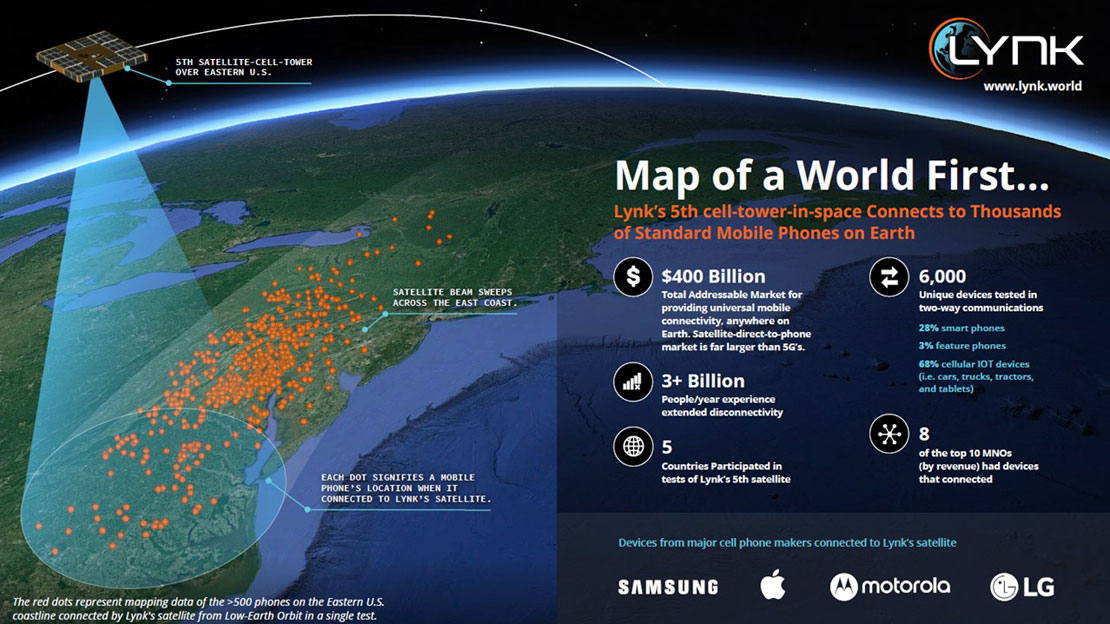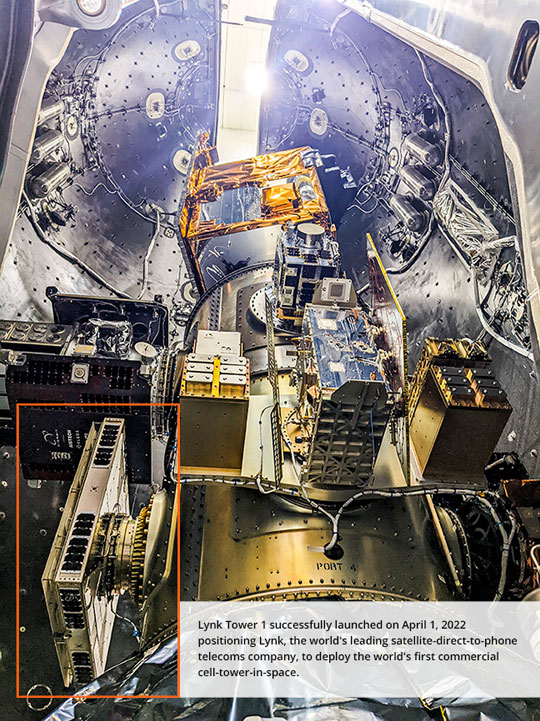 Lynk’s 5th cell-tower-in-space Connects to Thousands of Standard Mobile Phones on Earth
Lynk’s 5th cell-tower-in-space Connects to Thousands of Standard Mobile Phones on Earth
The world is more connected than ever with 5.3 billion mobile users around the globe and some 14 billion IoT devices. Yet, there are still billions of people who lack the most basic coverage and the vast majority of the Earth’s surface is out of range of a cell tower. Satellites providing direct-to-mobile phone service carry the immediate promise of increasing connectivity without affecting how providers build phones or deliver service.
Lynk Global, headquartered in Virginia, began exploring ways to close the connectivity gap several years ago, investigating the possibility of establishing a two-way connection between a satellite and an unmodified cell phone on the ground. By 2020, the team demonstrated the commercial viability of “cell towers in space” by relaying a text message from a LEO satellite approximately 500km above the earth’s surface to an unaltered Android phone on the Falkland Islands. By the end of the year, Lynk will have a fully operational commercial service.
“Everybody’s conventional wisdom was, ‘You can’t do that,’” Lynk CEO Charles Miller told Constellations. “But when you actually do the hard work…you realize the conventional wisdom is wrong. That’s the source of all great businesses: where conventional wisdom is wrong.”
To date, Lynk has raised over $27 million for its satellite communication network, including a recent $1 million investment from Virginia Innovation Partnership Corporation (VIPC). It has secured contracts with 12 mobile network operators (MNOs) worldwide and recently ran a test that successfully connected thousands of mobile users on eight of 10 of the world’s largest mobile networks. In July, Lynk was awarded the top prize in the Mercedes-Benz car2space Challenge for applying its technology to vehicles using standard, third-generation 3GPP chipsets and making zero hardware or software changes. In total, Lynk has launched six satellites, including one commercial bird. It plans to expand its commercial constellation to four satellites that will immediately provide text and SMS service to customers before the end of the year.
How Does Lynk Work?
Taking the idea of “cell towers in space” from theory to practice required the company to solve three fundamental problems. First, it had to demonstrate the possibility of a two-way connection by calculating the link budget from a satellite to a mobile phone. Second, the Lynk team had to ensure it could share spectrum with terrestrial systems without causing interference. The third challenge was accounting for the vast distance between the satellite in orbit and the device on the ground.
The first problem was a matter of physics, Miller noted. Solving the second problem (spectrum sharing) took “three-dimensional thinking,” he said—in a reference Star Trek fans could appreciate. Lynk used the same power flux density rules that prevent interference among neighboring terrestrial cell towers and applied them to transmissions from space.
“In existing ground-based terrestrial spectrum in the 850 and 900 MHz bands, we demonstrated we can connect phones from space and do so without causing harmful interference,” Miller explained, adding the method was proven through several U.S. tests monitored by mobile operators.
 Lynk Tower 1 successfully launched on April 1, 2022 positioning Lynk, the world’s leading satellite-direct-to-phone telecoms company, to deploy the world’s first commercial cell-tower-in-space.
Lynk Tower 1 successfully launched on April 1, 2022 positioning Lynk, the world’s leading satellite-direct-to-phone telecoms company, to deploy the world’s first commercial cell-tower-in-space.
The third problem required some sleight of hand. To make the system backward compatible with existing mobile technology, the Lynk team equipped their satellites with the same software stacks used in terrestrial cell networks, including core elements like the subscriber database. The next part of the challenge was accounting for the time and distance between the device and the satellite.
According to protocol, most cell towers can only reach devices within a range of 20 km – 100 km. So, what happens when the “cell tower” is 500 km overhead and traveling at a speed of about 7.8 km per second? “We trick the phone into thinking the cell tower—which is our satellite—is very close,” Miller explained.
When the connected device makes a request, the Lynk satellite does instantaneous geolocation and Doppler offset, essentially telling the phone it is within a range of just a few kilometers. That technique also enables seamless service between terrestrial cell towers and Lynk satellites. “We spoof the phone into thinking, indirectly, that the satellite is on the ground and rather close,” Miller continued. “Because we do the trick on time delay and framing, the phone thinks the satellite is right next to it.”
Applications: Life-saving Connectivity
Ultimately, Lynk’s end goal is to have a constellation of around 1,000 satellites providing continuous talk, text and data coverage. Getting to that point will likely take about five years, according to Miller. But the company isn’t waiting. Before the end of 2022, Lynk’s small handful of deployed satellites will be providing intermittent SMS text coverage for millions of mobile users in remote areas.
Mobile users who sign up for the service through participating MNOs will be able to send and receive messages whenever a Lynk satellite does an overpass, or about once an hour. The frequency will increase as the company builds out its constellation and it will eventually extend to continuous talk, text and data. Miller emphasized that having intermittent service is not a bug but a “business and ethical choice.” The idea is to connect as many people as possible using SMS, while the company builds out the capacity for talk and data.
“The question you have to ask: is that good enough for some people?” he noted. “Our feedback from the market, again and again, is sign me up now, that can save my life.”
According to Lynk estimates, roughly 15% of mobile users live, work or travel outside the range of a cell tower. Providing even limited connectivity will be a valuable tool for emergency service providers around the world.
“We know from experience that ubiquitous communication saves lives,” Miller said, citing the 1999 super cyclone that killed 15,000 in and around the Bay of Bengal. When the catastrophic Amphan cyclone hit the same area in 2020, India’s widespread adoption of mobile communications and early warning systems helped reduce fatalities by 99%.
While satellite phones offer an alternative to zero connectivity, the expensive hardware and service plans have been a barrier for those who need it most. Today, more companies are looking to offer satellite-based mobile phone service to existing devices. AST SpaceMobile is currently in the testing phase of its direct-to-cell satellite service. Inmarsat, a mobile services leader and longtime provider of satellite phones, is also working on a backward compatible service to connect 5G devices. The network is scheduled to be available sometime after 2026.
Explore More:
PDI finds ‘Underserved’ Markets with New MicroGEO
Podcast: The Intersection of LEO and 5G, Lower Power Connectivity
What Can the Space Industry Learn From Telecom About 5G?
Podcast: Commercial Infrastructure for Space Communication
